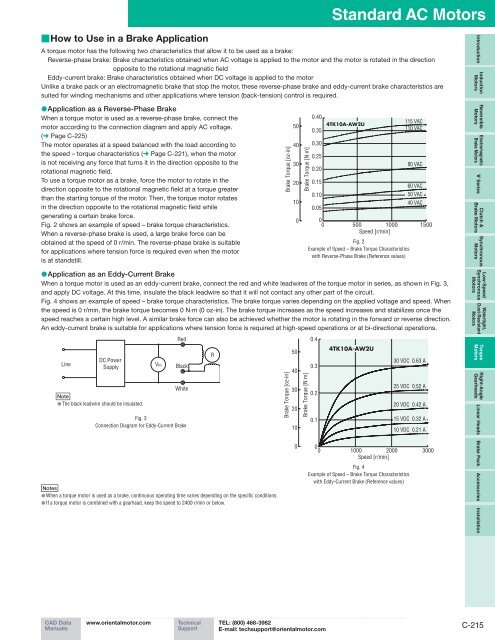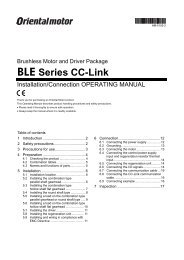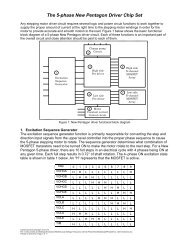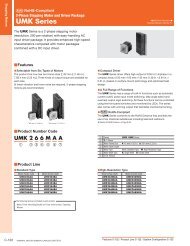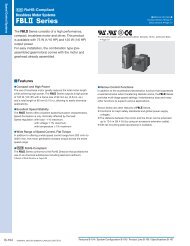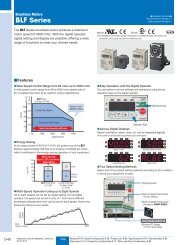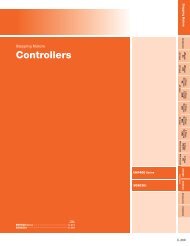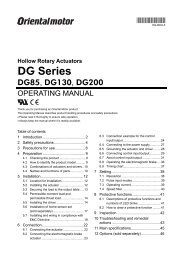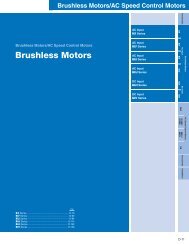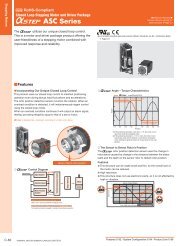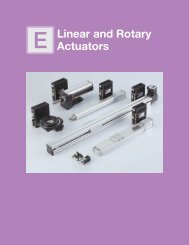Torque Motors - Oriental Motor
Torque Motors - Oriental Motor
Torque Motors - Oriental Motor
Create successful ePaper yourself
Turn your PDF publications into a flip-book with our unique Google optimized e-Paper software.
Standard AC <strong><strong>Motor</strong>s</strong><br />
■How to Use in a Brake Application<br />
A torque motor has the following two characteristics that allow it to be used as a brake:<br />
Reverse-phase brake: Brake characteristics obtained when AC voltage is applied to the motor and the motor is rotated in the direction<br />
opposite to the rotational magnetic field<br />
Eddy-current brake: Brake characteristics obtained when DC voltage is applied to the motor<br />
Unlike a brake pack or an electromagnetic brake that stop the motor, these reverse-phase brake and eddy-current brake characteristics are<br />
suited for winding mechanisms and other applications where tension (back-tension) control is required.<br />
●Application as a Reverse-Phase Brake<br />
When a torque motor is used as a reverse-phase brake, connect the<br />
motor according to the connection diagram and apply AC voltage.<br />
(➜ Page C-225)<br />
The motor operates at a speed balanced with the load according to<br />
the speed – torque characteristics (➜ Page C-221), when the motor<br />
is not receiving any force that turns it in the direction opposite to the<br />
rotational magnetic field.<br />
To use a torque motor as a brake, force the motor to rotate in the<br />
direction opposite to the rotational magnetic field at a torque greater<br />
than the starting torque of the motor. Then, the torque motor rotates<br />
in the direction opposite to the rotational magnetic field while<br />
generating a certain brake force.<br />
Fig. 2 shows an example of speed – brake torque characteristics.<br />
When a reverse-phase brake is used, a large brake force can be<br />
obtained at the speed of 0 r/min. The reverse-phase brake is suitable<br />
for applications where tension force is required even when the motor<br />
is at standstill.<br />
●Application as an Eddy-Current Brake<br />
When a torque motor is used as an eddy-current brake, connect the red and white leadwires of the torque motor in series, as shown in Fig. 3,<br />
and apply DC voltage. At this time, insulate the black leadwire so that it will not contact any other part of the circuit.<br />
Fig. 4 shows an example of speed – brake torque characteristics. The brake torque varies depending on the applied voltage and speed. When<br />
the speed is 0 r/min, the brake torque becomes 0 N·m (0 oz-in). The brake torque increases as the speed increases and stabilizes once the<br />
speed reaches a certain high level. A similar brake force can also be achieved whether the motor is rotating in the forward or reverse direction.<br />
An eddy-current brake is suitable for applications where tension force is required at high-speed operations or at bi-directional operations.<br />
Line<br />
DC Power<br />
Supply<br />
Note<br />
●The black leadwire should be insulated.<br />
VDC<br />
Red<br />
Black<br />
White<br />
Fig. 3<br />
Connection Diagram for Eddy-Current Brake<br />
Notes<br />
●When a torque motor is used as a brake, continuous operating time varies depending on the specific conditions.<br />
●If a torque motor is combined with a gearhead, keep the speed to 2400 r/min or below.<br />
R<br />
Brake <strong>Torque</strong> [oz-in]<br />
Brake <strong>Torque</strong> [oz-in]<br />
50<br />
40<br />
30<br />
20<br />
10<br />
0<br />
50<br />
40<br />
30<br />
20<br />
10<br />
0<br />
Brake <strong>Torque</strong> [N·m]<br />
Brake <strong>Torque</strong> [N·m]<br />
0.40<br />
0.35<br />
0.30<br />
0.25<br />
0.20<br />
0.15<br />
0.10<br />
0.05<br />
0.4<br />
0.3<br />
0.2<br />
0.1<br />
4TK10A-AW2U<br />
0<br />
0 500 1000 1500<br />
Speed [r/min]<br />
Fig. 2<br />
Example of Speed – Brake <strong>Torque</strong> Characteristics<br />
with Reverse-Phase Brake (Reference values)<br />
4TK10A-AW2U<br />
30 VDC 0.63 A<br />
25 VDC 0.52 A<br />
20 VDC 0.42 A<br />
15 VDC 0.32 A<br />
10 VDC 0.21 A<br />
0<br />
0 1000 2000 3000<br />
Speed [r/min]<br />
Fig. 4<br />
Example of Speed – Brake <strong>Torque</strong> Characteristics<br />
with Eddy-Current Brake (Reference values)<br />
115 VAC<br />
110 VAC<br />
80 VAC<br />
60 VAC<br />
50 VAC<br />
40 VAC<br />
Introduction<br />
Induction<br />
<strong><strong>Motor</strong>s</strong><br />
Reversible<br />
<strong><strong>Motor</strong>s</strong><br />
Electromagnetic<br />
Brake <strong><strong>Motor</strong>s</strong><br />
V Series<br />
Clutch & Synchronous<br />
Brake <strong><strong>Motor</strong>s</strong> <strong><strong>Motor</strong>s</strong><br />
Low-Speed<br />
Synchronous<br />
<strong><strong>Motor</strong>s</strong><br />
Watertight,<br />
Dust-Resistant<br />
<strong><strong>Motor</strong>s</strong><br />
<strong>Torque</strong><br />
<strong><strong>Motor</strong>s</strong><br />
Right-Angle<br />
Gearheads<br />
Linear Heads Brake Pack Accessories Installation<br />
CAD Data<br />
Manuals<br />
www.orientalmotor.com<br />
Technical<br />
Support<br />
TEL: (800) 468-3982<br />
E-mail: techsupport@orientalmotor.com<br />
C-215


